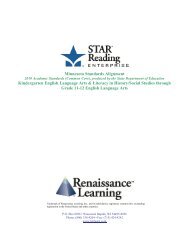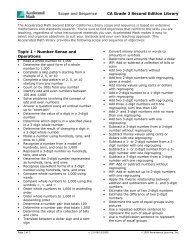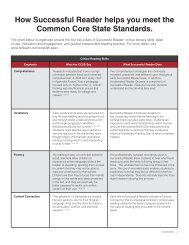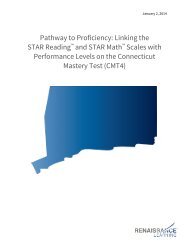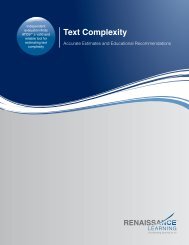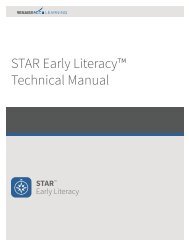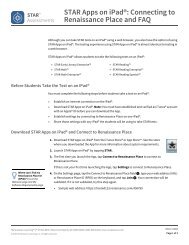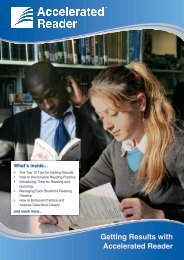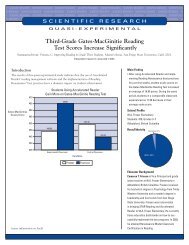New Thinking in Response to Intervention - Renaissance Learning
New Thinking in Response to Intervention - Renaissance Learning
New Thinking in Response to Intervention - Renaissance Learning
Create successful ePaper yourself
Turn your PDF publications into a flip-book with our unique Google optimized e-Paper software.
Components of RTI<br />
An RTI process consists of key components, <strong>in</strong>clud<strong>in</strong>g universal screen<strong>in</strong>g, high-quality core <strong>in</strong>struction,<br />
progress moni<strong>to</strong>r<strong>in</strong>g, tiered <strong>in</strong>terventions, collaborative data-based decision mak<strong>in</strong>g, parent <strong>in</strong>volvement, and<br />
adm<strong>in</strong>istrative support (Table 1). A full description, discussion, and details of these components is beyond the<br />
scope of this paper and can be found <strong>in</strong> excellent practitioner resources such as Burns and Gibbons (2008),<br />
Qu<strong>in</strong>n (2009), and Wright (2007). This paper focuses on assessment with<strong>in</strong> RTI.<br />
Table 1. Components of RTI<br />
Universal Screen<strong>in</strong>g<br />
• All children assessed at beg<strong>in</strong>n<strong>in</strong>g, middle, and end of school year on<br />
skills identified as highly predictive of future success or failure<br />
• Assesses the overall success of the core <strong>in</strong>struction (Tier 1)<br />
High-Quality, Standards-<br />
Aligned Instruction<br />
• Core <strong>in</strong>struction delivered <strong>to</strong> all students us<strong>in</strong>g a research-based,<br />
empirically supported program that is closely aligned <strong>to</strong> state standards<br />
and/or Common Core State Standards<br />
Progress Moni<strong>to</strong>r<strong>in</strong>g<br />
• Conducted on an ongo<strong>in</strong>g basis over time for students who are <strong>in</strong> need<br />
of tiered supports beyond Tier 1<br />
• Assessment frequency is more periodic than universal screen<strong>in</strong>g,<br />
usually at least once per week<br />
• Data are sensitive <strong>to</strong> student improvement over time; sufficient data <strong>to</strong><br />
establish a reliable trend must be collected<br />
Tiered <strong>Intervention</strong>s<br />
Collaborative, Data-Based<br />
Decision Mak<strong>in</strong>g<br />
Parental Involvement<br />
Adm<strong>in</strong>istrative Support<br />
• Supplemental, research-based <strong>in</strong>structional <strong>in</strong>terventions <strong>to</strong> core<br />
<strong>in</strong>struction derived from a problem-solv<strong>in</strong>g process and focused on<br />
student needs<br />
• Usually delivered <strong>in</strong> small groups, with larger groups at Tier 2 than Tier 3<br />
• Teams of school professionals exam<strong>in</strong>e multiple data sources <strong>to</strong> discuss<br />
the appropriate <strong>in</strong>tervention <strong>to</strong> impact the child<br />
• The number and nature of the team structure is often def<strong>in</strong>ed by the<br />
local context (i.e., school-level versus grade-level data teams)<br />
• Engagement of parents <strong>in</strong> the process of understand<strong>in</strong>g and<br />
support<strong>in</strong>g the efforts <strong>to</strong> provide <strong>in</strong>structional support<br />
• Ma<strong>in</strong>ta<strong>in</strong> close and frequent communication with parents about<br />
student progress<br />
• Leadership at central, build<strong>in</strong>g, and teacher levels provide key<br />
supports <strong>to</strong> the process<br />
• Adm<strong>in</strong>istrative support for <strong>in</strong>frastructure, schedule, materials,<br />
ongo<strong>in</strong>g professional development, and build<strong>in</strong>g consensus<br />
8





